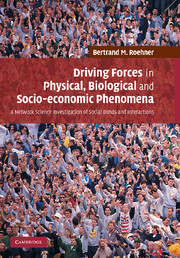 Driving Forces in Physical, Biological and Socio-economic Phenomena
Driving Forces in Physical, Biological and Socio-economic Phenomena Published online by Cambridge University Press: 02 December 2009
The purpose of this book is to explore the similarities as well as the differences between natural and social phenomena. While several chapters are devoted to the second objective, the main message of the book is to show that the experimental methodology which has been used so successfully in the natural sciences can also be applied to social phenomena.
Basically, one can distinguish two main approaches in the social sciences, the anthropomorphic perspective and the system theory approach. Throughout this book we try the second of these options. In order to illustrate them, let us consider the phenomenon of suicide. In the anthropomorphic perspective one would try to establish connections between suicide and psychiatric disorders. In the system theory approach one tries to formulate the problem of suicide in a more general framework in which the interactions between the elements composing the system play the key role. This approach was pioneered by the sociologist Emile Durkheim at the end of the nineteenth century. He was able to show that there is a clear relationship between the likelihood of suicide and the strength of the bonds which link an individual to the rest of the society. The main challenge (and prerequisite) in the application of the network science approach is to be able to estimate the strength of the interactions between the elements of the system. This is also the main stumbling-block because both system theory and network science are mathematical frameworks which provide useful modeling tools but do not tell us how to investigate complex, interconnected networks and how to measure the interactions between their elements.
To save this book to your Kindle, first ensure [email protected] is added to your Approved Personal Document E-mail List under your Personal Document Settings on the Manage Your Content and Devices page of your Amazon account. Then enter the ‘name’ part of your Kindle email address below. Find out more about saving to your Kindle.
Note you can select to save to either the @free.kindle.com or @kindle.com variations. ‘@free.kindle.com’ emails are free but can only be saved to your device when it is connected to wi-fi. ‘@kindle.com’ emails can be delivered even when you are not connected to wi-fi, but note that service fees apply.
Find out more about the Kindle Personal Document Service.
To save content items to your account, please confirm that you agree to abide by our usage policies. If this is the first time you use this feature, you will be asked to authorise Cambridge Core to connect with your account. Find out more about saving content to Dropbox.
To save content items to your account, please confirm that you agree to abide by our usage policies. If this is the first time you use this feature, you will be asked to authorise Cambridge Core to connect with your account. Find out more about saving content to Google Drive.